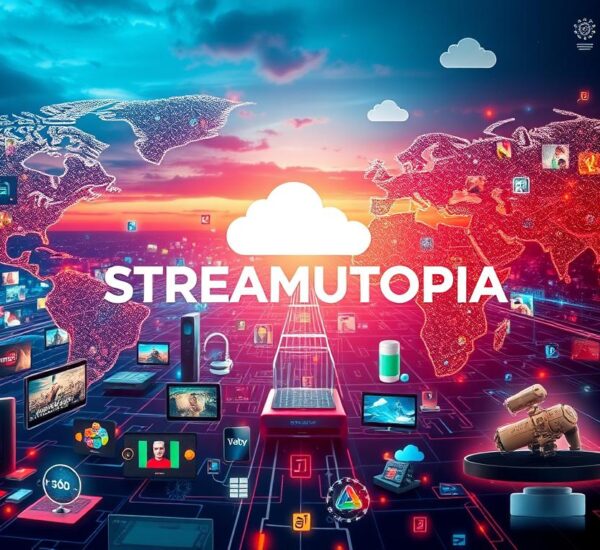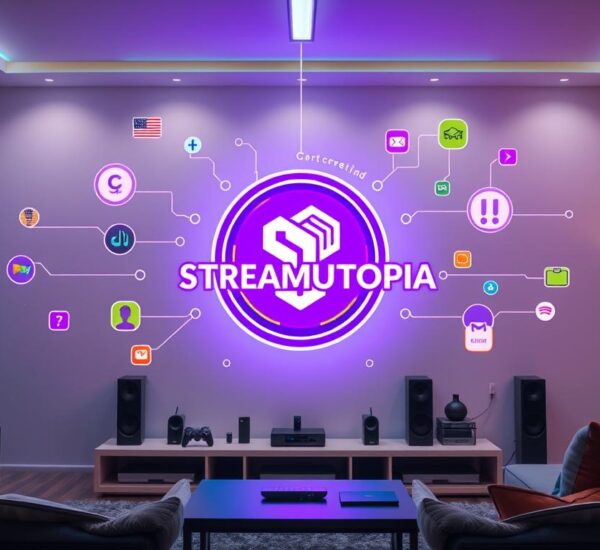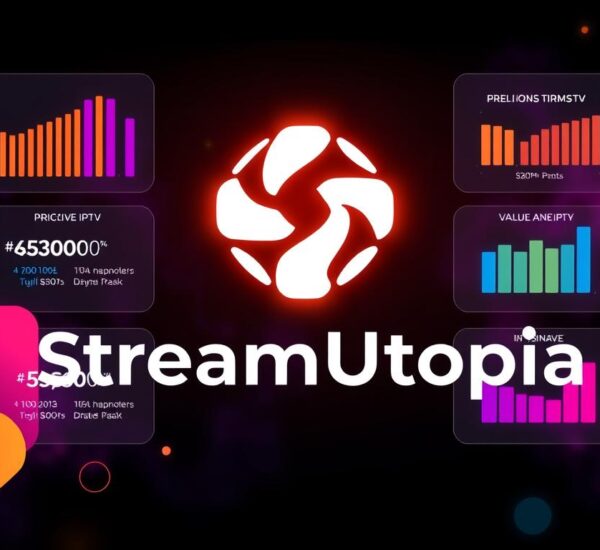Did you know that the future of interactive TV is set to revolutionize the media industry? With the integration of gamification and viewer engagement, television is undergoing a remarkable transformation that enhances user experience and expands audience reach. This innovative approach combines the interactive features of mobile gaming with the wide audience base of television, creating a new era of entertainment and interactivity.
As the TV industry seeks to stay ahead of the curve, gamification and viewer engagement have emerged as prominent trends driving innovation. In this article, we will explore the exciting developments and possibilities that lie ahead in interactive TV, highlighting the benefits, challenges, and strategies for successful implementation.
Key Takeaways:
- Gamification and viewer engagement are transforming the future of interactive TV.
- The integration of mobile games with television enhances user engagement and expands audience reach.
- There are technical challenges to consider, such as compatibility and development complexity.
- Conducting a thorough viability analysis and exploring strategic partnerships are crucial for successful implementation.
- Gamification in television marketing creates interactive experiences, fosters brand loyalty, and allows for measuring success.
Pros of Mobile Game Integration with Television
Integrating mobile games with television offers numerous advantages, ranging from enhanced user engagement to expanded audience reach and monetization potential. By combining the interactive features of mobile gaming with the broader audience of television, this integration creates a synergy that captivates viewers and delivers a more immersive entertainment experience.
Enhanced User Engagement: Mobile game integration with television provides users with an interactive experience that encourages active participation. By incorporating elements such as quizzes, polls, and real-time voting, viewers can engage with their favorite shows in a whole new way, fostering a deeper connection with the content.
Expanded Audience Reach: The integration of mobile games with television attracts not only traditional TV viewers but also the growing population of mobile gamers. This expanded audience reach helps TV networks and streaming platforms tap into new markets and demographics, allowing them to diversify their viewer base and increase overall viewership.
Monetization Potential: One of the most significant benefits of mobile game integration with television is the monetization potential it offers. Increased user engagement attracts advertisers who are willing to invest in targeted advertising during interactive segments. Additionally, in-app purchases within the integrated games contribute to revenue streams, creating further monetization opportunities for content creators.
To illustrate the advantages of mobile game integration, let’s take a look at the following table:
| Advantages | Description |
|---|---|
| Enhanced User Engagement | Provides an interactive experience and fosters active participation |
| Expanded Audience Reach | Attracts both traditional TV viewers and the growing population of mobile gamers |
| Monetization Potential | Increased engagement attracts advertisers and in-app purchases contribute to revenue streams |
Cons of Mobile Game Integration with TV — Technical Challenges
While integrating mobile games with television offers numerous benefits, there are also a few technical challenges that need to be considered. These challenges can impact the compatibility, development complexity, and budget requirements of the integration process.
Compatibility: One of the main technical challenges is ensuring compatibility across different devices and platforms. Mobile games are developed for a wide range of operating systems, screen sizes, and hardware specifications. This requires additional time and resources to optimize the games for each platform and ensure smooth performance across all devices.
Development Complexity: Integrating mobile games with television can be technically complex, requiring expertise in both mobile game development and television software engineering. This means that additional technical resources may be needed to successfully implement the integration. Hiring experts in both domains can lead to significant budgetary considerations, increasing the overall cost of the project.
Budget Requirements: Determining the budget for mobile game integration with television can be challenging due to the technical complexities involved. Conducting a detailed feasibility study and consulting with experts in the field can help provide accurate budget estimates. By considering factors such as development time, resource requirements, and potential additional costs, it becomes possible to create a realistic budget plan.
To summarize, while mobile game integration with television offers exciting possibilities for enhanced user engagement and expanded audience reach, it is essential to navigate the technical challenges related to compatibility, development complexity, and budget requirements. By carefully assessing these challenges and planning accordingly, successful integration can be achieved.
Technical Challenges Summary
| Challenges | Description |
|---|---|
| Compatibility | Ensuring compatibility across different devices and platforms |
| Development Complexity | Technical complexity requiring expertise and potential budget considerations for hiring experts |
| Budget Requirements | Determining the budget for integration considering technical complexities and additional costs |
Viability Analysis
Before integrating mobile games with television, conducting a viability analysis is crucial. This analysis involves evaluating market demand, return on investment, technical feasibility, and potential strategic partnerships. Let’s delve into each aspect:
Market Demand
Understanding the market demand is essential for the success of integrating mobile games with television. By analyzing competitor offerings and market trends, we can gauge the potential audience and their interest in interactive TV experiences. This analysis helps identify gaps in the market and allows for tailored strategies to capture the attention of the target audience.
Return on Investment
Calculating the return on investment is a vital component of the viability analysis. This assessment involves estimating the potential revenue generated by the integration of mobile games with television and comparing it to the associated costs. By considering factors such as user adoption, monetization strategies, and market dynamics, we can determine the profitability of the venture and make informed decisions.
Technical Feasibility
Evaluating the technical feasibility ensures the successful implementation of mobile games integration with television. This assessment involves considering factors such as compatibility across different devices and platforms, development complexity, and resource requirements. By addressing potential challenges beforehand, we can minimize technical obstacles and streamline the integration process.
Strategic Partnerships
Exploring strategic partnerships with TV networks, streaming platforms, or game development studios can enhance the viability of integrating mobile games with television. Collaborating with established players in the industry leverages their expertise, resources, and existing user base. These partnerships can help navigate challenges, accelerate growth, and unlock new opportunities for reaching a wider audience.

| Aspect | Key Considerations |
|---|---|
| Market Demand |
|
| Return on Investment |
|
| Technical Feasibility |
|
| Strategic Partnerships |
|
Understanding Gamification in Television Marketing
Gamification in television marketing is a powerful strategy that involves integrating game elements into non-game situations to enhance interactivity, engagement, and rewards. By incorporating gamified experiences into television shows, marketers can captivate viewers and create immersive interactions that drive brand loyalty and audience growth.
The Power of Interactive Experiences
Television shows have the opportunity to organize various interactive experiences to increase viewer participation and engagement. These can include:
- Polls and Surveys: Television programs can conduct real-time polls and surveys to gather viewer opinions and feedback on specific topics or to involve them in decision-making processes.
- Quizzes and Trivia: Engaging viewers with quizzes and trivia games related to the show’s content can not only boost interaction but also enhance audience knowledge and retention.
- Real-Time Voting: Allowing viewers to vote in real-time on different aspects of the show, such as choosing the winner, the next storyline direction, or even the outcome of a competition, fosters a sense of involvement and investment in the program.
These interactive experiences encourage viewers to become active participants, creating a deeper connection with the content and fostering a sense of belonging.
Building Brand Loyalty Through Gamified Advertising
Gamified advertising is another effective way to enhance viewer engagement and brand loyalty. By incorporating game elements into advertisements, marketers can create memorable and enjoyable experiences that entertain and resonate with the audience. Some examples of gamified advertising strategies include:
- Contests and Sweepstakes: Running contests or sweepstakes within television ads creates excitement and incentivizes viewers to actively engage with the brand’s offering. Prizes and rewards further motivate participation and can help build brand loyalty.
- Challenges and Achievements: Introducing challenges and achievements through advertising campaigns enables viewers to unlock exclusive content, discounts, or virtual rewards. This gamified approach fosters a sense of accomplishment and encourages continued engagement with the brand.
These gamified advertising strategies not only capture viewers’ attention but also provide valuable data that can be used to refine marketing strategies and create more personalized campaigns in the future.
Measuring Success in Gamification
Measuring the success of gamification in television marketing is crucial for optimizing strategies and achieving desired outcomes. Key metrics to consider when evaluating the effectiveness of gamification campaigns include:
- Viewer Preferences: Understanding viewer preferences and analyzing data on engagement levels, interaction patterns, and participation rates helps identify successful gamified experiences and tailor future initiatives accordingly.
- Ad Effectiveness: Assessing the impact of gamified advertising on brand awareness, message retention, and purchase intent provides insights into the effectiveness of different approaches and informs future ad campaigns.
- Audience Growth: Monitoring audience growth and tracking the acquisition and retention of viewers as a result of gamified experiences helps quantify the impact of interactive initiatives on expanding the show’s reach.
By regularly evaluating these metrics, marketers can continuously optimize gamification strategies to drive viewer engagement, strengthen brand loyalty, and achieve measurable success.
| Gamification Benefits | Gamification Challenges |
|---|---|
| Enhanced viewer engagement | Technical complexity and compatibility issues |
| Expanded audience reach | Budget requirements for development and integration |
| Monetization opportunities through advertising revenue and in-app purchases |
A Case Study: Bandersnatch-Black Mirror
A notable case study in the gamification of television is the Netflix Black Mirror episode called Bandersnatch. This interactive Netflix episode introduced a unique and engaging experience for viewers by combining elements of the show with interactive gaming. In Bandersnatch, viewers were given the power to make decisions that actively impact the plot, using a choose-your-own-adventure (CYA) story format.
By offering interactive video content, Bandersnatch successfully captured viewer engagement and pushed the boundaries of traditional TV-watching experiences. The episode achieved great success, garnering over 45 million views in its first week alone. Its popularity serves as a testament to the audience’s desire for immersive and interactive content.
Through the use of branching narratives and viewer choices, Bandersnatch allows viewers to shape the story and explore multiple pathways. This level of interactivity not only increases viewer engagement but also creates a more personalized viewing experience.
Interactive Video Content: Empowering Viewer Engagement
Bandersnatch demonstrates the potential of interactive video content in driving viewer engagement. By involving viewers in the storytelling process, this episode immerses them in a world where their decisions impact the outcome of the narrative. Such interactivity adds a layer of excitement and agency, making the viewing experience more immersive and memorable.
Through the success of Bandersnatch, Netflix has further solidified its position as a pioneer in interactive entertainment. The popularity of this episode has paved the way for additional interactive experiences, showing the industry the vast possibilities that lie ahead.
- Interactive storytelling sparks curiosity and promotes active participation from viewers.
- Viewers feel a sense of ownership over the narrative, creating a deeper connection with the content.
- Multiple storylines and choices provide replay value, encouraging viewers to explore different paths.
- Interactive video content allows for personalized viewing experiences, catering to individual preferences.
The Impact of “Bandersnatch” on the TV Industry
Bandersnatch has not only captivated audiences but also sparked conversations within the TV industry. This interactive Netflix episode has opened up new possibilities for storytelling and viewer engagement, inspiring content creators to explore the potential of interactive narratives.
The success of Bandersnatch has also encouraged other streaming platforms and networks to experiment with interactive video content. This shift towards interactivity is shaping the future of television and challenging traditional linear storytelling.
The Future of Interactive TV: Viewer Empowerment and Engagement
As the TV industry continues to evolve, viewer engagement remains at the forefront. Interactive content like Bandersnatch demonstrates the power of immersive experiences that empower viewers and create a deeper connection with the content they consume.
The success of Bandersnatch paves the way for further experimentation and innovation in interactive television. With the evolution of technology and increasing viewer demand, the future of interactive TV holds endless possibilities for engaging and personalized entertainment experiences.
Second Screen Experiences: A New Layer of Engagement
Second screen experiences are transforming the traditional TV-watching landscape by introducing an additional layer of engagement to viewers. With the use of smartphones, tablets, or laptops alongside their primary viewing device, audiences can access supplementary information, interact with shows in real time, and consume complementary content. This interactive platform enhances the TV-watching experience, empowering viewers to delve deeper into show-related material, actively participate in discussions, and share their opinions. As a result, TV watching becomes a more social and community-driven activity.
One of the key advantages of second screen experiences is the ability to access a wealth of complementary content. By using their personal devices, viewers can explore behind-the-scenes footage, character profiles, or in-depth analysis related to the show they are watching. This added layer of information enriches the viewing experience and satisfies the audience’s curiosity for more in-depth storytelling.
In addition to accessing supplementary content, second screens enable real-time interaction with TV shows. Viewers can actively participate in live polls, voting, or interactive quizzes, allowing them to directly impact the outcome of a show or event. This level of engagement immerses viewers in the content and makes them feel like active contributors to the unfolding narrative.
Moreover, second screen experiences cultivate a sense of community by providing viewers with a platform to share their thoughts, opinions, and reactions. Dedicated apps or social media platforms allow audiences to connect with others who have similar interests, fostering meaningful discussions and creating a shared viewing experience.
The image below illustrates the concept of second screen experiences in action:

Table: Benefits of Second Screen Experiences
| Advantages | Explanation |
|---|---|
| Access to complementary content | Viewers can explore additional materials related to the TV show, enhancing their understanding and enjoyment. |
| Real-time interaction | Through second screens, viewers can actively participate in live polls, voting, and interactive quizzes, influencing the outcome of a show or event. |
| Community and social engagement | Second screens provide a platform for viewers to connect with others, share their thoughts, and engage in meaningful discussions. |
Social TV and Real-Time Engagement: Bringing Viewers Together
Social TV combines the immersive nature of television content with the interactive capabilities of social media platforms, creating a rich space for viewers to engage, share, and discuss in real time. Viewers use second screens, such as smartphones or tablets, to interact with content related to what they are watching on the main screen. This digital multitasking fosters a sense of community and collective enjoyment, as fans can congregate, interact, and share their thoughts during live events, popular shows, or premieres.
The Second Screen Phenomenon
The second screen phenomenon revolutionizes the traditional television experience by providing viewers with a complementary platform for engaging with content. By using their smartphones or tablets alongside their primary viewing device, viewers can access real-time information, participate in interactive features, and join online discussions. This phenomenon transforms TV watching from a solitary activity to a communal space where viewers can connect with others who share their interests and deepen their enjoyment of the content.
Real-Time Engagement and Communal Enjoyment
Real-time engagement through social TV allows viewers to actively participate and shape the conversation around their favorite shows. Whether it’s live tweeting, joining dedicated Facebook groups, or participating in online forums, viewers can express their opinions, theories, and reactions in the moment. This communal space facilitates collective enjoyment, as viewers celebrate shared experiences, analyze plot twists, and form virtual communities. Social TV fosters a sense of belonging and allows viewers to feel connected to a larger community of fans, enhancing their overall viewing experience.
| Benefits of Social TV and Real-Time Engagement | Examples |
|---|---|
| Instant feedback: Viewers can provide real-time feedback to broadcasters and production teams, influencing the direction of future episodes or seasons. | Fan campaigns: Fans can band together to express support for a show or advocate for its continuation, leading to increased engagement and potential renewals. |
| Exclusive behind-the-scenes content: Networks and streaming platforms can offer additional content, such as interviews or behind-the-scenes footage, to enhance viewer engagement and foster a deeper connection to the shows. | Live chats: Platforms provide opportunities for live chats during broadcasts, enabling viewers to interact with cast members, creators, and fellow fans, creating memorable experiences. |
| Interactive polls and quizzes: Viewers can participate in real-time polls and quizzes related to the show, stimulating engagement and allowing them to share their opinions with the wider community. | Virtual watch parties: Online platforms enable viewers to host virtual watch parties where they can chat, react, and share their thoughts with friends and fans, fostering a sense of togetherness. |
Image: Social TV and Real-Time Engagement
Interactive Narratives and Choose-Your-Own-Adventure Content: The Rise of Viewer Control
Interactive narratives and choose-your-own-adventure content have revolutionized the TV-watching experience by giving viewers unprecedented control over the outcome of a story. With these interactive storytelling formats, viewers become active participants, shaping the direction and ending of the narrative based on their choices. This level of viewer control enhances personalization and engagement, creating a more immersive and satisfying TV-watching experience.
By offering interactive narratives, TV shows and movies allow viewers to become co-creators of the story, influencing its development and ultimately determining the outcome. This unique form of engagement caters to the viewer’s desire for agency and personalization, as they actively shape the story based on their preferences and decisions.
Choose-your-own-adventure content, popularized by books and video games, has made a successful transition to television, allowing viewers to explore different storylines and endings. This format involves presenting viewers with choices at key points in the narrative, prompting them to decide which path the story should take. Each choice leads to a different outcome, offering viewers a highly personalized and interactive viewing experience.
Interactive narratives and choose-your-own-adventure content have become particularly popular in streaming platforms, where viewers have the freedom to engage with the content at their own pace. Platforms like Netflix have released interactive shows, such as “Black Mirror: Bandersnatch,” where viewers can make choices that shape the story as it unfolds.
The rise of viewer control through interactive narratives and choose-your-own-adventure content has several key benefits:
- Personalized Experience: By making choices and influencing the story, viewers feel a stronger connection and investment in the narrative, creating a more personalized experience.
- Enhanced Engagement: Interactive storytelling formats keep viewers actively engaged, fostering a deeper level of concentration and enjoyment.
- Replay Value: The ability to explore different storylines and endings encourages viewers to rewatch and experience the content in various ways, increasing its value and longevity.
- Highly Memorable: Interactive narratives and choose-your-own-adventure content leave a lasting impression on viewers due to their unique and interactive nature.
To illustrate the impact of interactive narratives and choose-your-own-adventure content, here is an example of viewer choices and their corresponding outcomes in an interactive TV show:
| Choice | Outcome |
|---|---|
| Choose to investigate the mysterious noise | Discover a hidden passage leading to a secret chamber |
| Choose to ignore the noise and continue exploring | Stumble upon a valuable artifact |
| Choose to confront the main antagonist | Engage in a thrilling confrontation resulting in a satisfying resolution |
| Choose to seek help from a secondary character | Form an unlikely alliance and unveil a shocking plot twist |
Interactive narratives and choose-your-own-adventure content provide a unique and engaging TV-watching experience that empowers viewers to control the story. As the demand for personalization and engagement continues to grow, we can expect to see more innovative formats that offer even greater levels of viewer control.
Enhanced Reality (AR) and Virtual Reality (VR) Integration: The Future Is Here
Enhanced Reality (AR) and Virtual Reality (VR) technologies are revolutionizing the television viewing experience, paving the way for an immersive future. AR enhances the real-world environment by overlaying digital information, truly enhancing the way we interact with the world around us. On the other hand, VR creates fully simulated environments that transport users into a virtual world, providing an extraordinary level of immersion.
By integrating AR and VR into television, the boundaries between viewers and content are shattered, transforming passive viewers into active participants in their favorite shows and movies. With AR, viewers can witness digital objects seamlessly blended into their surroundings, creating a new layer of interactivity and engagement. VR, on the other hand, enables viewers to step into virtual worlds and experience narratives from a first-person perspective, further enhancing immersion and storytelling.
The integration of AR and VR technologies has the potential to unlock countless possibilities in the entertainment industry. Viewers can explore interactive narratives, where their choices and actions shape the course of the story, providing a personalized and captivating experience. Additionally, advertisements and product placements can become more dynamic and engaging, with AR allowing viewers to interact with virtual products, try them out, and make informed purchasing decisions.
Furthermore, AR and VR integration in television can revolutionize live events and sports broadcasts, allowing viewers to not just observe, but actively participate in the action. Imagine watching a football match with AR overlays that provide real-time player statistics, replays, and interactive challenges. VR can transport fans to the best seats in the stadium or even directly onto the field, allowing them to experience the thrill of sports up close and personal.
AR and VR technologies are rapidly evolving, and the future of television is set to be increasingly immersive and interactive. As these technologies continue to advance and become more accessible, viewers can look forward to a future where their favorite shows and movies become transformative experiences that blur the line between reality and digital worlds.
Applications of AR and VR Integration in Television
| Application | Description |
|---|---|
| Interactive Narratives | Viewers become active participants, making choices that impact the story’s progression. |
| Enhanced Advertisements | AR allows viewers to interact with virtual products and make informed purchasing decisions. |
| Sports Broadcasts | VR transports fans to the best seats in the stadium or directly onto the field for an immersive sports experience. |
| Live Events | AR overlays provide real-time information, replays, and interactive challenges during live performances or events. |
Gamification of TV Content: Beyond Traditional Watching
The gamification of TV content goes beyond traditional passive watching and offers interactive entertainment that engages viewers on a deeper level. Gamification involves incorporating game elements into TV shows to enhance interactivity and engagement. Viewers become active participants, enjoying a more involved and immersive TV-watching experience. The industry is responding to the demand for interactive content by exploring innovative ways to transform traditional television into interactive entertainment.
Gamification of TV content allows viewers to actively participate in the storyline, making decisions that impact the outcome. This level of viewer involvement enhances the overall entertainment value and creates a sense of ownership over the viewing experience. By integrating game mechanics such as challenges, rewards, and competition, TV shows can captivate audiences and foster deeper engagement.
Benefits of Gamification in TV Content:
- Increased viewer engagement and interactivity.
- Stronger emotional connection with the storyline and characters.
- Enhanced entertainment value and overall viewer satisfaction.
- Opportunities for audience participation and social interaction.
Examples of Gamified TV Content:
| TV Show | Description |
|---|---|
| The Walking Dead: Our World | A mobile game connected to the TV show that allows players to fight zombies in their own neighborhood. |
| Hole in the Wall | A game show where contestants have to contort their bodies to fit through moving cutout shapes on a wall. |
| Jeopardy! | A trivia-based game show that allows viewers to play along and test their knowledge. |
Gamification of TV content opens up new possibilities for interactive storytelling and viewer involvement. As technology continues to advance, we can expect even more immersive and engaging experiences in the future, blurring the lines between gaming and traditional television. This shift towards interactive entertainment reflects the evolving preferences of viewers who seek more personalized, engaging, and participatory forms of media consumption.
Conclusion
The integration of gamification and viewer engagement with television is poised to revolutionize the entertainment industry. With advancements in technology and the increasing demand for interactive and personalized experiences, the future of interactive TV looks incredibly promising. Through the combination of gamification techniques, second screen experiences, social TV interactions, interactive narratives, and the integration of augmented reality (AR) and virtual reality (VR), the way we consume and engage with TV content is being transformed.
By incorporating game elements into TV shows and embracing interactive entertainment, viewers are no longer passive spectators but active participants. This shift in dynamic provides a more immersive and engaging TV-watching experience. As a result, the media industry is evolving to meet the demand for more interactive and personalized content.
The future of interactive TV holds great potential in captivating audiences and shaping the evolution of the media industry. Advancements in technology will continue to enable new and exciting possibilities for viewer engagement. With gamification, second screen experiences, social TV, interactive narratives, and the integration of AR/VR, the future of interactive TV is set to captivate and transform the way we consume entertainment.
FAQ
What are the advantages of integrating mobile games with television?
What are the technical challenges associated with integrating mobile games with television?
How can I conduct a viability analysis for integrating mobile games with television?
What is gamification in television marketing?
Can you provide a case study of gamification in television?
What are second screen experiences in television?
How does social TV enhance viewer engagement?
What are interactive narratives in television?
What is the role of AR and VR integration in television?
How does gamification enhance TV content?





